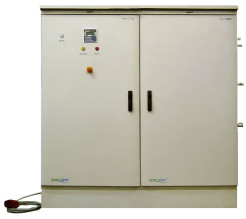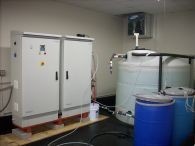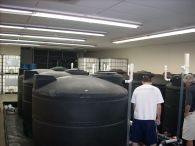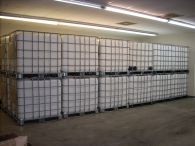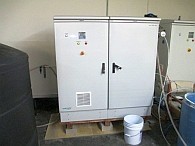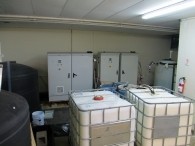 Anolyte and Catholyte solutions have been used for stimulation and enhancement of oil and gas production and to improve performance of drilling fluids. Anolyte is a highly effective alternative to bactericides that are non-biodegradable or bio-accumulative. As a bactericide, Anolyte is selective, targeting bacteria responsible for microbial induced corrosion and slime while being safe to humans. Catholyte has been used to replace diesel oil as a cleaning solution for drill bits and tools on site.
Anolyte and Catholyte solutions have been used for stimulation and enhancement of oil and gas production and to improve performance of drilling fluids. Anolyte is a highly effective alternative to bactericides that are non-biodegradable or bio-accumulative. As a bactericide, Anolyte is selective, targeting bacteria responsible for microbial induced corrosion and slime while being safe to humans. Catholyte has been used to replace diesel oil as a cleaning solution for drill bits and tools on site.
Envirolyte anolyte solutions can be used to enhance production from wells which have been impacted by down-hole growth of bacteria, and other micro-organisms, by killing the bacteria and removing the restrictive biomass.
Water used for the fracturing of oil and gas wells can be treated with anolyte solutions to manage bacteria, protecting fracturing fluids and gels, and ensuring polymer and improved performance. Anolyte solutions remove scale and slime build-up from pipes, and cooling water systems can be kept free of biomass, improving heat exchange values and eliminating corrosion caused microbial induced corrosion (MIC). Produced water may be treated before being revised in stimulation fluids or water floods.
Recent data collected from field operations where frac water was treated with anolyte, shows that the bacteria levels in the frac water were reduced below the threshold level that would adversely impact stimulation fluids and gels.
Envirolyte ELA-5000HD | Catholyte has been shown to substantially reduce the surface tension of water and can be used to condition water used to stimulate well production.
Anolyte has some catholyte properties as well and, being a biocide, is a surfactants itself to some extent, of course. Use of anolyte along with catholyte at the oil rigs results in recovering more oil using low cost and environmentally friendly ingredients. In addition to what is said above Anolyte prevents microbial contamination of down hole injection of water during oil recovery. Anolyte reduces the need for traditional disinfection chemicals, which can be expensive, highly toxic and potentially hazardous for to transport and store.
The quality of injection water is critical. It must be free from suspended solids and have a low oxygen content to prevent the growth of anaerobic micro-organisms. It is also important that the water is free from anaerobic bacteria, especially sulphate-reducing bacteria, which flourish in anaerobe conditions by reducing existing sulphate ions to hydrogen sulphide gas(H2S). H2S is highly corrosive andreduces the market value of the oil by increasing its sulphide content, causing pipelines corrosion and can be a potential health hazard to personnel. |
Oil and Gas Applications
- Frac Water – For typical water treatment, mix 5 litres of Anolyte with 1000 liters of frac water to 2.5 ppm FAC to mitigate and retard the growth of non-public health micro-organisms such as anaerobic bacteria, aerobic bacteria and sulphite reducing bacteria to protect fracturing fluids, polymers and gels.
- Sour Wells - For typical well treatment, slug dose ~ 600-650 litres at 500 ppm FAC of Anolyte into the well bore on a daily or weekly basis to control unwanted non-public health micro-organisms, reduce hydrogen sulphide gas and restore well integrity. *
- Produced Waters - For typical produced water treatment, mix ~21 litres of Anolyte with 1000 litres of produced water to 10.5 ppm FAC to retard the growth of non-public health micro-organisms. *
- Heaters, Hydrocarbon Storage Facilities & Gas Storage Wells - For typical storage facility treatment, mix ~ 500-550 litres of Anolyte at 500 ppm FAC into the water phase of the mixed hydrocarbon/water system to retard the growth of non-public health microorganisms, control the formation of hydrogen sulfide and reduce corrosion of the storage tanks. *
- Water Flood Injection Water - For typical water flood injection water treatment, mix 21 litres of Anolyte with 1000 liters of injection water to 10.5 ppm FAC to retard the growth of non-public health microorganisms and control slime on pipelines. *
- Oil and Gas Transmission Lines - For typical transmission line treatment, slug dose ~ 1650-1700 litres at 500 ppm FAC of Anolyte into the transmission line on a daily or weekly basis to control unwanted non-public health microorganisms, such as SRB's, reduce microbiologically influenced corrosion (MIC) and remove the slime and assosiated sessile bacteria which can degrade pipeline integrity. *
Important note: The dosing regimes advised above depend on the source water and may vary depending on the contamination of the treated objects or, in other words, FAC demand. It all may influence the dosing and result in higher volumes of anolyte.
So far introduction if this enhanced oil recovery (EOR) technology to the industry was hindered by the absence of generators capable to produce big volumes of the fluids (1000 LPH - 6000 LPH). By now Envirolyte has developed this type of anolyte/catholyte generators and made them serial products. A typical Envirolyte EOR system is highly compact and easy to install within exciting pipework with minimal disruption. In addition Envirolyte EOR technology does not produce any unwanted products. Moreover, what makes anolyte and catholyte application in oil & gas industries extremely attractive is production cost of anolyte/catholyte.
* This information is taken from generic data in the public domain. The treatments using Envirolyte Anolyte – trade name Envirolyte O&G (EPA-registered # 87636-1) - are dependant upon the oil shale’s and are commercially sensitive information.
Exactly the same principal of Envirolyte disinfection can be applied to the treatment of drinking water on offshore platforms. Envirolyte disinfection system can be used after storage, at the point of use, to eliminate bacteria, mould, yeasts and fungi which contaminate water supplies.
Generally, anolyte and catholyte solutions have been effective in the management of bacteria and other micro-organisms in oil and gas production. Working with Envirolyte equipment and solutions in the oil and gas industry, it is now possible to utilize this unique EOR technology to improve production and profits and do so in an environmentally responsible and cost effective manner.
Anolyte manufacturing and distribution plant in Houston, Texas
Anolyte Envirolyte O&G generator |
Anolyte & Catholyte storage Vats |
275 Gallon UV Totes for Transportation to Well sites |
Envirolyte ELA- 5000HD generator |
Envirolyte ELA- 5000HD & ELA-10000 | 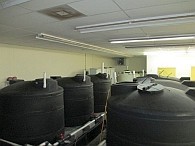 Storage tanks |
For instruction details or applications please send Your enquiry ![]()

